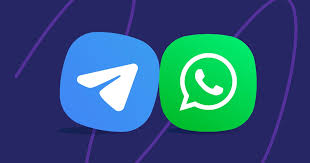Using your smartphone or tablet to send messages can no longer be tolerated in our modern busy lives. And that’s where web clients come into play, giving us easy access to the same messaging features from a computer or laptop. Meanwhile, two of the leading messaging services in the world, WhatsApp and Telegram, have terrific web applications: WhatsApp Web and Telegram Web. But when the two suites go head-to-head on a larger screen, which one really comes out on top? The answer to this depends highly on whether you prefer your messenger to be seamless or more feature-rich than the other.
The Foundation: Mirroring vs. Independence
Most importantly, the difference comes down to the basic architecture. WA Web is essentially a shadow of your mobile phone. It’s not a stand-alone application. You really have to have your smartphone connected to the internet in order for WA Web to work. You scan a QR code with your phone’s WhatsApp Web scanner, and the session remains active as long as your smartphone is online. AdvertisementThis has the benefit of perfect sync with 100% consistency but it has a downside: in the event that your phone battery dies or your phone loses connection, WhatsApp Web will crash.
Telegram Web on the other hand is much more independent of your phone; while you still need your phone to authorize the session by sending you a code, once logged in, the web client can run even without your phone. That’s because Telegram maintains all your messages and media on its secure cloud servers. This independence is a big plus when you don’t always have your main device with you, but need full access to your chat history on a computer.
User Interface and Ease of Use
When it comes to a clean, intuitive interface, both platforms excel but with different philosophies. WhatsApp Web presents a familiar, no-frills experience that closely mimics the mobile app. The layout is simple: a left pane for chats and a right pane for the active conversation. This simplicity makes it incredibly easy for anyone to pick up and use immediately. The focus is squarely on your individual and group chats, with clear icons for attachments, emojis, and voice messages.
Telegram Web has a more feature-packed interface that can be slightly more complicated, but which is also customizable. Unlike Telegram Online it uses a multi-column layout that users can change, and has a persistent search bar that lets you quickly find messages, files, or links. There is also a more detailed settings menu that allows you to control a lot more from within the chat itself. While some experts might be less familiar with it, it’s easy to see why power users love the sheer volume of options that are readily available.
Features and Functionality: Where They Diverge
The same area on which Telegram Web really shines – WA Web provides the basics – text messages, emojis, file sharing (with a limit of 2GB which is generous) and voice calls. It is accurate in the bare minimums of what most people will want from WhatsApp Web.
- Telegram Web actually is quite robust as it supports a few fancy stuff which WA Web sadly does not have like:
- Usernames and Public Channels: you can interact with public channels and users without disclosing your phone number.
- Bots Telegram’s bot ecosystem is extremely large, and you can do everything from automatizing tasks to playing games directly in the web client.
- Enhanced File Sharing: More file types will be supported, as well as more control over the sharing of media / documents.
- Customization You can customize your themes, choose an animated chat background per conversation and use animated stickers far more often.
Editing & Pin the Message You can edit sent messages as well as pin multiple messages in a chat as a way to have more control over your messages.
Security and Privacy Considerations
Both apps take security seriously, but on different approaches. WhatsApp Web gets some of the advantages of WhatsApp’s end-to-end encryption (usually using AES for all of your chats) with which every single chat is encrypted at all times the relay process between your phone and web browser.
Telegram uses a proprietary encryption protocol known as MTProto. Though it allows end-to-end encryption, it does not allow this by default for cloud chats (it only supports it in its “Secret Chats” feature) that you cannot have in Telegram Web. So your normal cloud chats on the web are encrypted between you and Telegram’s servers, but Telegram holds the encryption keys. If you want maximum security it’s fine. But some privacy purists might prefer what WhatsApp Web offers: general end-to-end encryption.
The Verdict: Which One is Better for You?
As long as you want it to be easy, reliable for a basic communication experience and have the added peace of mind that WhatsApp Web features default end-to-end encryption. If you mainly use messaging for personal chats with friends and family and you don’t mind having a more traditional WhatsApp experience then WA Web is the sleek and simple choice. The fact that all of your WhatsApp Web chats are kept synced up instantly is a big plus for the massive user base.
If you’re a power user, who cares about features, customization and independence from your phone, you’ll love Telegram Web. If you are part of large groups, channels, or use bots for productivity and entertainment, Telegram Web’s superior functionality is unbeatable. Its cloud-native design makes it a more robust and flexible tool for professional and heavy-duty personal use.
In conclusion, while WhatsApp Web perfects the art of simple, encrypted messaging, Telegram Web offers a glimpse into the future of feature-rich, cloud-based communication. Your better platform is the one that aligns with how you communicate.

